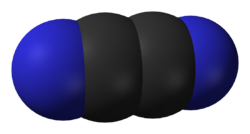Chemistry:Carbon nitride
From HandWiki
Short description: Chemical compound made of carbon and nitrogen
In organic chemistry, carbon nitrides are compounds consisting only of carbon and nitrogen atoms. Carbon nitrides are also known as organic semiconductors with a band gap of 2.7 eV. Due to its hydrogen-bonding motifs and electron-rich properties, this carbon material is considered a potential candidate for material applications in carbon supplementation. [1]
Covalent network compounds
- Beta carbon nitride - a solid with a formula β-C
3N
4, which is predicted to be harder than diamond. - Graphitic carbon nitride - g-C
3N
4, with important catalytic and sensor properties.[2] - C
3N
5 - a combined triazole and triazine framework.[3] - MCN-12 (C
3N
6) and MCN-13 (C
3N
7).[4]
Azafullerenes
- Azafullerenes are a class of heterofullerenes in which the element substituting for carbon is nitrogen.[5] Examples include (C
59N)
2 (biazafullerenyl),[6] C
58N
2 (diaza[60]fullerene), C
57N
3 (triaza[60]fullerene) and C
48N
12.
Cyanofullerenes
- Cyanofullerenes are a class of modified fullerenes in which cyano- groups are attached to a fullerene skeleton. These have the formula C
60(CN)
2n, where n takes the values 1 to 9.
Cyanogen
- Cyanogen - C
2N
2 (N≡C–C≡N) - Isocyanogen - C
2N
2 (−
C≡N+
–C≡N) - Diisocyanogen - C
2N
2 (−
C≡N+
–+
N≡C−
) - Paracyanogen - a cyanogen polymer, (NCCN)
n - Paraisocyanogen - a cyanogen polymer, (CNCN)
n
Percyanoalkynes, -alkenes and -alkanes
- dicyanoacetylene - C
4N
2 or N≡C–C≡C–C≡N, also called carbon subnitride or but-2-ynedinitrile - tetracyanoethylene - C
6N
4 or (N≡C–)
2C=C(–C≡N)
2 - tetracyanomethane - C
5N
4 or C(–C≡N)
4 - 2,2-diisocyanopropanedinitrile - C
5N
4 or (−
C≡N+
–)
2C(–C≡N)
2 - hexacyanoethane - C
8N
6 or (N≡C–)
3C–C(–C≡N)
3 - hexacyanocyclopropane - C
9N
6 or C
3(CN)
6 - hexacyanobutadiene[7] - C
10N
6 or C
4(CN)
6
Dicyanopolyynes
Dicyanopolyynes are composed of a chain of carbon atoms with alternating single and triple bonds, terminated by nitrogen atoms. Although not a polyyne dicyanoacetylene (N≡C–C≡C–C≡N) otherwise fits within this series.
- C
6N
2 or N≡C–C≡C–C≡C–C≡N, dicyanobutadiyne (dicyanodiacetylene) - C
8N
2 or N≡C–C≡C–C≡C–C≡C–C≡N, dicyanohexatriyne - C
10N
2 or N≡C–C≡C–C≡C–C≡C–C≡C–C≡N - C
12N
2 or N≡C–C≡C–C≡C–C≡C–C≡C–C≡C–C≡N - C
14N
2 or N≡C–C≡C–C≡C–C≡C–C≡C–C≡C–C≡C–C≡N - C
16N
2 or N≡C–C≡C–C≡C–C≡C–C≡C–C≡C–C≡C–C≡C–C≡N - C
18N
2 or N≡C–C≡C–C≡C–C≡C–C≡C–C≡C–C≡C–C≡C–C≡C–C≡N - C
20N
2 or N≡C–C≡C–C≡C–C≡C–C≡C–C≡C–C≡C–C≡C–C≡C–C≡C–C≡N - C
22N
2 or N≡C–C≡C–C≡C–C≡C–C≡C–C≡C–C≡C–C≡C–C≡C–C≡C–C≡C–C≡N
Perazidoalkynes, -alkenes and -alkanes
- tetraazidomethane - CN
12 or C(–N=N+
=N−
)
4
Percyanoheterocycles
- pentacyanopyridine - C
10N
6 - tetracyanopyrazine - C
8N
6 - tricyanotriazine - C
6N
6[8] - tetracyano-bitriazine - C
10N
10[8] - dicyanotetrazine - C
4N
6 - hexacyanotrisimidazole - C
15N
12 - hexacyanohexaazatriphenylene - C
18N
12
Aromatic cyanocarbons
- hexacyanobenzene - C
12N
6 - octacyanonaphthalene - C
18N
8 - decacyanoanthracene - C
24N
10
Other compounds
- cyanonitrene - CN
2 or [N≡C–N ⇌ −
N=C=N+
⇌ +N=C=N−
⇌ N–C≡N] (one of the nitrogens is univalent) - azodicarbonitrile - C
2N
4 or N≡C–N=N–C≡N, cis and trans isomers - cyanogen azide - CN
4 or N≡C–N=N+
=N− - 1-diazidocarbamoyl-5-azidotetrazole - C
2N
14 - 2,2′-azobis(5-azidotetrazole) - C
2N
16 - triazidotriazine (cyanuric triazide) - C
3N
12 (C
3N
3(N
3)
3) - triazidoheptazine - C
6N
16 (C
6N
7(N
3)
3) - tricyanomethanimine (dicyanomethylene-cyanamide) - C
4N
4 or N≡C–N=C(–C≡N)
2 - diazidodicyanoethylene - C
4N
8 or (−
N=N+
=N–)
2C=C(–C≡N)
2 and (−
N=N+
=N–)(N≡C–)C=C(–N=N+
=N−
)(–C≡N), cis and trans - dicyanodiazomethane - C
3N
4 or (N≡C–)
2C=N+
=N− - dicyanocarbene - C
3N
2 or CII
(–C≡N)
2 (and isomers cyanoisocyanocarbene −
C≡N+
–CII
–C≡N, diisocyanocarbene −
C≡N+
–CII
–+
N≡C−
, 3-cyano-2H-azirenylidene and 3-isocyano-2H-azirenylidene) - 1,3,5-triazido-2,4,6-tricyanobenzene - C
9N
12 (C
6(CN)
3(N
3)
3) - nitrogen tricyanide N(–C≡N)
3 and carbon bis(cyanamide) N≡C–N=C=N–C≡N, two formal monomers of polymeric C
3N
4
Anions and functional groups
- cyanide - −
C≡N ion, cyanide –C≡N and isocyanide –+
N≡C−
functional groups - dicyanamide - N(CN)−
2 or −
N(–C≡N)
2 - tricyanomethanide - C(CN)−
3 or −
C(–C≡N)
3 - pentacyanoethanide - C
2(CN)−
5 or (N≡C–)
2C−
–C(–C≡N)
3 - pentacyanopropenide (pentacyanoallyl anion) - C
3(CN)−
5 - 2-dicyanomethylene-1,1,3,3-tetracyanopropanediide C
10N2−
6 - tricyanomelaminate anion - C
3N
3(NCN)3−
3 - melonate - C
6N
7(NCN)3−
3 - cyanofullerene anions - C
60(CN)
n−
(n odd) and C
60(CN)
n2− (n even) - cyanoacetlyide - C
3N−
or −
C≡C–C≡N - cyanobutadiynylide - C
5N−
or −
C≡C–C≡C–C≡N - cyanopolyynide anions - C
nN−
(n odd)
See also
References
- ↑ https://doi.org/10.1016/B978-0-12-823961-2.00008-2
- ↑ Lv, Hongying; Teng, Zhenyuan; Wang, Sicong; Feng, Ke; Wang, Xiaoli; Wang, Chengyin; Wang, Guoxiu (March 2018). "Voltammetric simultaneous ion flux measurements platform for Cu2+, Pb2+ and Hg2+ near rice root surface: Utilizing carbon nitride heterojunction film modified carbon fiber microelectrode". Sensors and Actuators B: Chemical 256: 98–106. doi:10.1016/j.snb.2017.10.053.
- ↑ I. Y. Kim, S. Kim, X. Jin, S. Premkumar, G. Chandra, N.-S. Lee, G. P. Mane, S.-J. Hwang, S. Umapathy, A. Vinu, Angew. Chem. Int. Ed. 2018, 57, 17135.
- ↑ Kim, I. Y., Kim, S., Premkumar, S., Yang, J.-H., Umapathy, S., Vinu, A., Thermodynamically Stable Mesoporous C3N7 and C3N6 with Ordered Structure and Their Excellent Performance for Oxygen Reduction Reaction. Small 2020, 16, 1903572.
- ↑ D.J. Harris, Discovery of Nitroballs: Research in Fullerene Chemistry, 1993 California State Science Fair, http://www.usc.edu/CSSF/History/1993/S05.html
- ↑ Hummelen et al, Isolation of the Heterofullerene C59N as Its Dimer (C59N)2, Science 269: 1554-1556 (1995)
- ↑ O.W.Webster, Hexacyanobutadiene, J. Am. Chem. Soc. 86(14): 2898–2902 (1964)
- ↑ 8.0 8.1 Sesto et al, Chemical Reduction of 2,4,6-Tricyano-1,3,5-triazine and 1,3,5-Tricyanobenzene. Formation of Novel 4,4',6,6'-Tetracyano-2,2'-bitriazine and Its Radical Anion, J. Org. Chem. 68: 3367-3379 (2003)
 |


